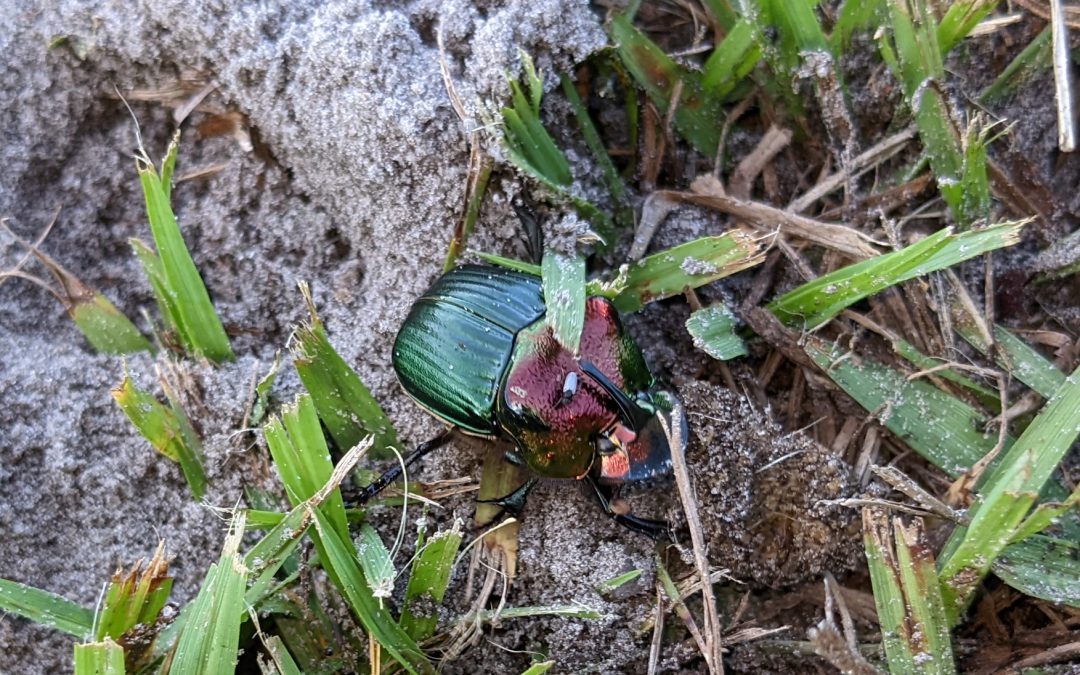
by Erik Lovestrand | Jul 21, 2022
Most of us have had the displeasure of hurrying to our car, late for some appointment, climbing in, only to be assaulted by…sniff-sniff…the overpowering stench of doggy poo on a shoe. I can handle many of nature’s nasty smells pretty well but this one nearly gags me. Imagine if this stuff never went away and kept accumulating on the ground. For any of us that have even one big dog, this would be a problem. Heaven help the dog lovers out there with two or more large canines. Well, this article will be paying homage to the unsung heroes of the manure-removal squad, who could give Mike Rowe a run for his money any day. You guessed it, dung beetles.
Dung beetles are most assuredly not the only critters who make their living by what we would consider disgusting means. Carrion beetles, fly maggots, vultures and many other creatures would qualify for an episode of “Dirty Jobs in the Animal Kingdom.” However, the incredible beauty of many species of scarab beetles (the group to which dung beetles belong), resulted in high reverence in the ancient Egyptian culture. In more recent times, humans have realized the benefits provided by dung beetles and have intentionally introduced them in some places to manage dung accumulation in pasture systems. Their tunneling not only takes the dung below for a nutrient recycling function but also brings soil castings to the surface, which reduces soil compaction and improves aeration.
I have seen dung beetles many times, as they work in the yard to reduce my chances of “stepping in it.” Until recently, I have not paid close attention to the incredible beauty of our local species. I had a great opportunity the other day to observe several beetles as they reduced a pile of dog mess to smaller messes and pulled them into their tunnels for long-term storage. The showy, metallic colors of red and green made it apparent why some refer to these creatures as “rainbow” scarabs. They were happy to ignore my presence as I took pictures only inches away from their frenzied activity to salvage their prized doggy treats.
The dung serves as food for both young and adults during periods when they remain underground. Females lay a single egg on what is referred to as a “brood ball” of dung and there may be several of these pre-packaged meals with an egg in the tunnel system made by the beetles. I was able to get some good photos of a beetle as it worked above ground moving dung balls away from the mother lode. It appears to be a species known as Phanaeus igneus, which occurs in our area along with a similar species named Phanaeus vindex. In Florida, Phanaeus igneus tends to occur in sandy soils, while P. vindex prefers clay-type soils. The finely sculptured elytra (hard wing covers) of P. igneus also distinguish it from P. vindex. Eggs hatch into a grub that matures below ground before emerging as a mature adult to continue the cycle.
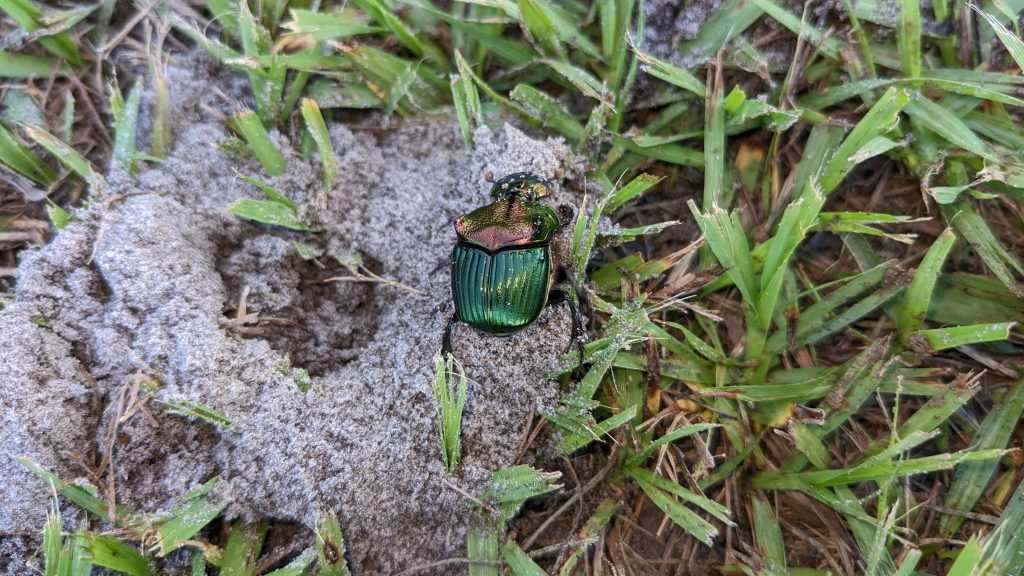
Females of this species are distinguished from males by the lack of a horn.
The dung beetle’s sense of smell is truly a wonder of nature. I have seen them flying in for a sniff test literally within minutes of deposition. Within the next day or two, the only evidence of your pooch’s crime will be small mounds of soil where the excavations took place. I was so taken with these little jewels of the manure pile that you might understand why I think you should be just as amazed. So, the next time you find a fresh pile in the yard, drop down to your knees for a closer look and be prepared to be amazed. If the manure-removal squad has not appeared on the scene yet, give them a few minutes. It won’t take very long. In the meantime, you can be thinking about how you will explain your behavior to your neighbors when they inquire.
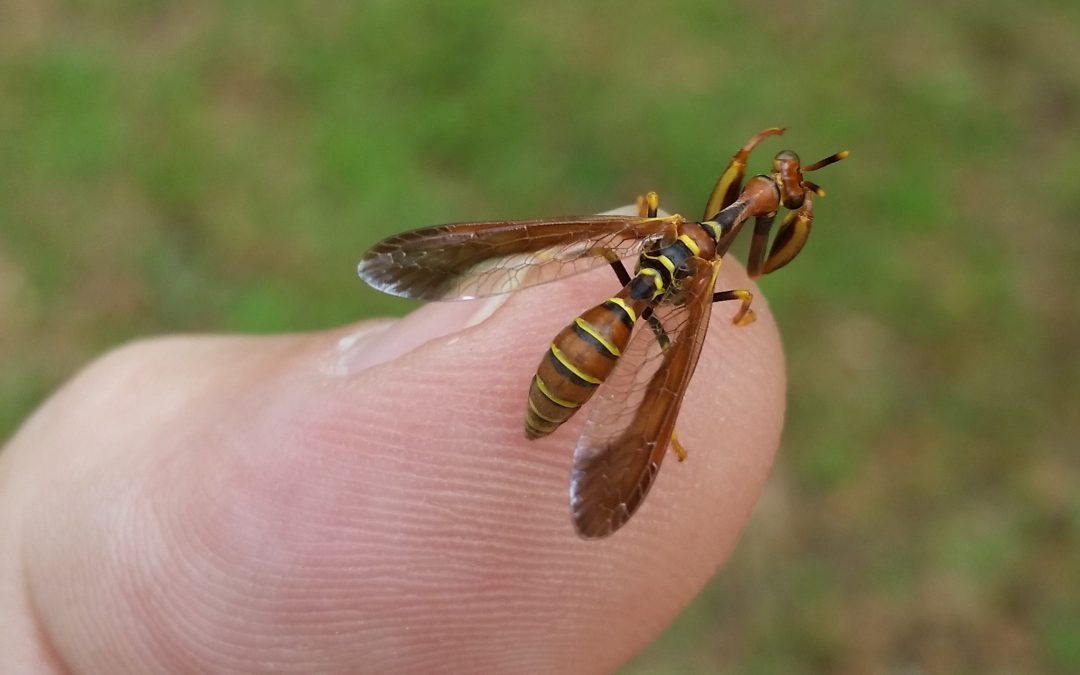
by Erik Lovestrand | Jun 23, 2022
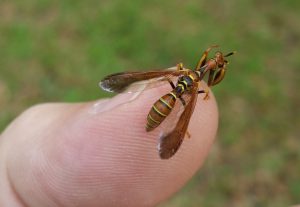
This praying mantis species mimics a wasp to avoid predation. Photo credit: Erik Lovestrand
When it landed on my hand, the first reaction was to brush it off as quickly as possible. However, something seemed to be slightly odd about this particular “wasp” that made me take another look. First, it was not prone to fly away as I moved my hand up for a better look. It even seemed okay with the interaction as I moved it around for a photo opportunity. There was also something odd about the shape of its body that wasn’t exactly wasp-like. As I looked closer, I realized that its head was very mantis-like and when it began grooming its antennae, I could make out the telltale folded arms that give the praying mantis its name. The yellow and black stripes encircling its abdomen, along with its wing shape and positioning veritably shouted “WASP!” I had never heard of a praying mantis that expertly mimicked a wasp so I did a quick internet search and found that this was a wasp mantidfly (neither a wasp nor a mantis). Mantidflies are grouped by scientists into a separate order called Neuroptera, which includes lacewings, antlions, owlflies, and others. Here are a few other mantidflies that mimic other wasp species.
A simple definition of mimicry would be: similarities between different species of animals. It is different from camouflage, which refers to an animal resembling an inanimate object, but both are effective forms of deception that generally benefit an animal in some way. Another common insect that would fool most people is the soldier fly. It definitely looks like something that could sting but closer examination will reveal only one pair of wings (a fly trait) rather than two, as bees and wasps have.
Now, not to take you too far into the weeds on this subject, but we should also mention the different types of mimicry that scientists have identified in nature and note an example of each. Henry Walter Bates studied butterflies in the Amazon and described a type of mimicry where one species mimicked the look of another that had some particularly nasty defense to predation. The mimic was lacking the defense mechanism but benefited by predators avoiding it based on its basic appearance. This type of mimicry is now known as Batesian mimicry and a good example are the butterflies that mimic the monarch. Monarchs are toxic because of the milkweed they eat during their larval stage. After a predator eats a few it learns to avoid anything that looks similar, such as a viceroy or queen butterfly. Fritz Mueller was a German zoologist who described a form of mimicry, now called Muellerian mimicry, where multiple species mimic each other and they all have a similar defense mechanism. This spreads the benefit to all that look similar by reducing predation pressure on all. The third type of mimicry is known as self mimicry, where an animal has one body part that mimics another (i.e. large eye spots to frighten or disorient an attacker), or a body part that may mimic some innocuous thing to fool prey into coming closer. We have a great example of this locally in the alligator snapping turtle. The tip of their tongue has a lure that resembles a worm and is capable of wiggling to enhance its effectiveness in tempting a fish to its doom in the vice-like jaws of the turtle.
Nature never ceases to amaze with the diversity and complexity of adaptations that various animals exhibit to gain an edge on the competition. When it comes to mimicry in the natural world, first impressions are generally wrong. I mean, that’s the point, right?
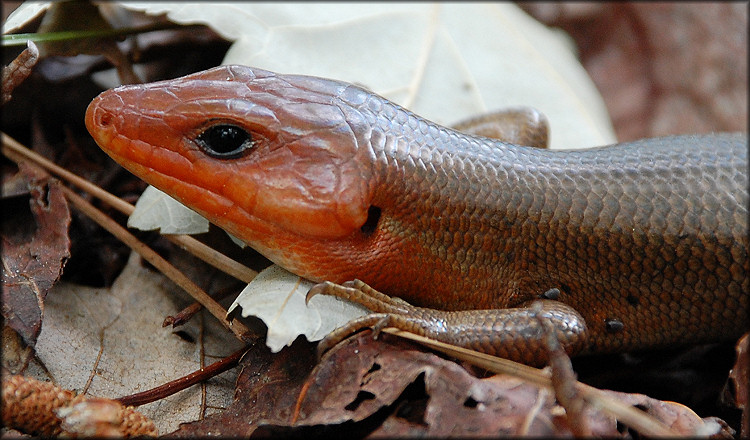
by Erik Lovestrand | May 26, 2022
Well, the answer to this question should be obvious, right? However, when we take a closer look at these interesting creatures, the first impression created by their frightful name will likely evaporate completely. First, scorpions are considered venomous, rather than poisonous (I know, a technicality). They have many predators that eat them with no ill effect so they are not poisonous. Anything that has the ability to deliver a toxin by means of injection is classified as venomous. Next, the name is a true misnomer because the group of animals referred to as blue-tailed scorpions are actually a type of lizard called a skink.
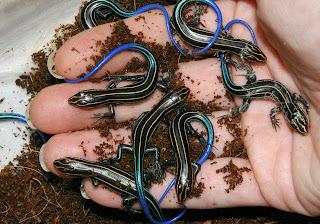
Hatchling broadhead skinks sport a brilliant blue tail but lose this color as they mature. Source: NSF-EID
Scincidae is just one of sixteen families of lizards worldwide but it contains some of the most beautiful species of reptiles. Florida is blessed (yes, blessed) with at least seven species of skinks, with one being divided into five sub-species. Three of the five sub-species of the mole skink have “protected” status under state or federal laws.
Several of our native skinks in the Panhandle are challenging to identify at first glance, particularly during their younger years. The five-lined, southeastern five-lined and broadhead skink are all striped and have blue tails as youngsters, hence the origin of the frightening title for this article. According to folklore, these animals have the ability to deliver a painful sting with their tail. Well, as a lifelong reptile enthusiast, I have had the experience of catching many young, blue-tailed skinks without any stings.
Now, back to the question of whether or not these blue-tailed skinks are poisonous. From everything that I have read, there is no scientific evidence that skinks are inherently toxic when eaten by other animals. It is theorized that they could potentially harbor Salmonella bacteria but I have never heard of a documented case of this either. Many people hold the belief that when a skink in eaten by a dog or cat, it causes the animal to hold its head cocked and wander off to one side when walking. Veterinarians refer to these symptoms as vestibular syndrome and often cannot diagnose a cause. Vestibular syndrome is related to the inner ear or the parts of the brain that control balance and a sense of orientation to gravity. Our family witnessed this once with a beagle that we had and it lasted for several weeks but gradually improved to the point of normalcy. We did not witness her eating a skink, although she could have. However, there are many other more likely causes for this behavior including, inner ear infections, cysts or tumors, head trauma, parasites, etc. I suspect that inner ear issues are a common cause.
The largest species of skink in the Southeastern U. S. is the broadhead (or broad-headed) skink, reaching lengths of nearly thirteen inches. When mature, these skinks lose the blue tail and most of their striping to become a tannish brown. Males are larger than females and have a reddish color on the head, which intensifies during the breeding season. If you want to identify this species as a juvenile, you will need to look at the scales on the underside of the tail to separate it from the two species of five-lined skinks that inhabit our area. The central row of scales will be significantly wider than the other rows on either side. Broadheads have powerful jaws and will bite if harassed. If you want to see two males engaged in epic combat, give a watch to this YouTube link: https://www.youtube.com/watch?v=Z8qbexnZWew . Their stamina is truly amazing and they definitely come out with some battle scars.
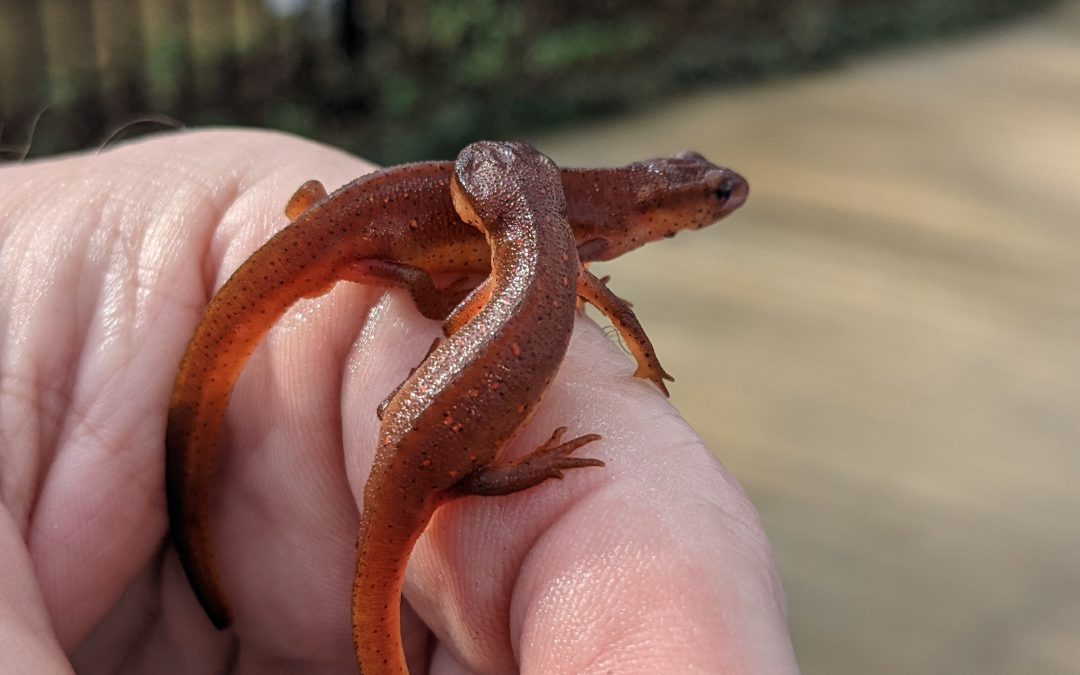
by Erik Lovestrand | Mar 4, 2022
Many of our local creatures lead fascinating lives that are rarely observed by the casual nature-seeker. However, thanks to those seriously committed naturalists, who may seriously need to be committed, we get the opportunity to peek into the secret lives of newts for some wild revelations. By the way, I do consider myself a naturalist and on occasion will come close to the edge of “crazy” in my nature adventures. Nevertheless, I do not believe I would actually qualify as “committable” because I have never totally lost that innate capacity to be freakishly startled when a treefrog jumps on the back of my neck in the dark. If you ever get past the point of being startled by things like that when on a nighttime herp hunting venture, you should probably speak with a professional.
Several months ago, I once again decided to test my measure of “committability” on a late night visit to the sinkhole pond behind my house. I was hoping to see what kinds of local amphibians might be active because I could hear several different frog species sounding off. As I waded in with my headlamp for a light source, I soon discovered that frogs are pretty darn good at not getting caught at night (imagine that). I had a dip net but never got close enough without scaring the quarry under. However, when I made a few scoops across the bottom in the shallows I was excited to see something wriggling among the leafy debris in the net.
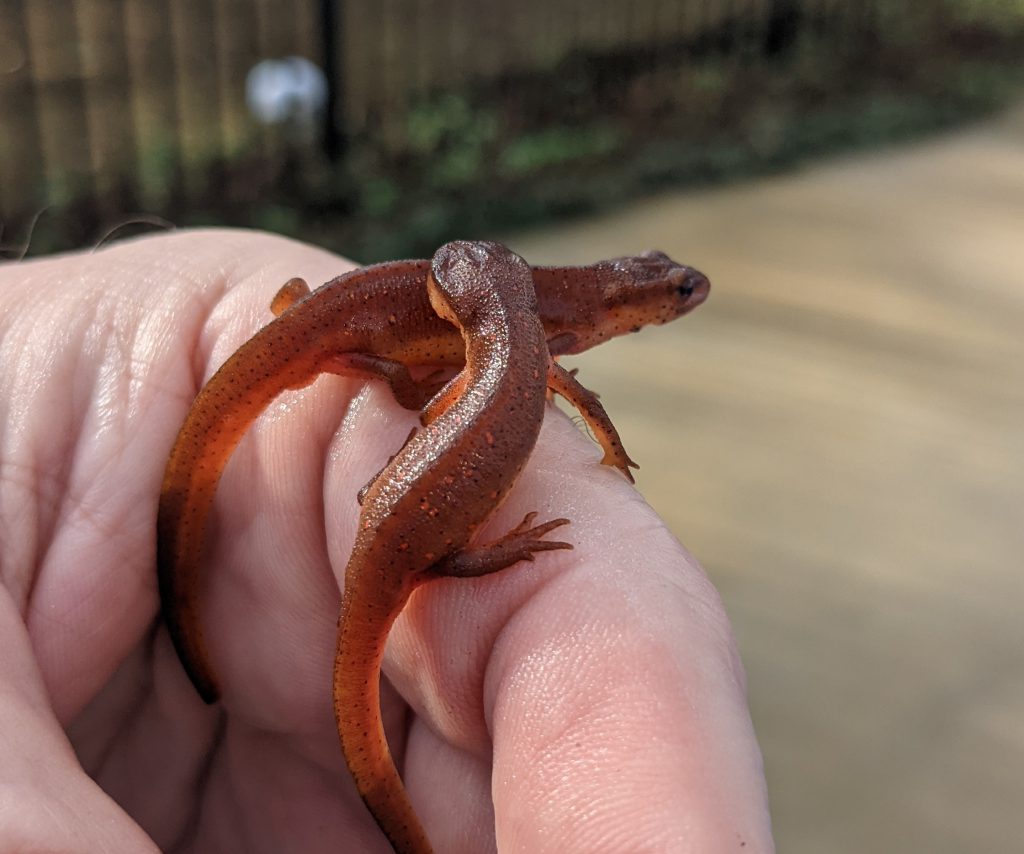
These two “eft-phase” eastern newts were rescued from the authors pool skimmer
Upon returning to the house, it didn’t take long to identify the three-inch long specimen as an eastern newt. As I later read more in depth about this species, I learned that newts are in the family called Salamandridae and typically (not always) have three distinct life phases where they go back and forth between the land and water. After the eggs hatch, larval newts are fully aquatic, with a pair of feathery external gills protruding behind their head. As they mature, they metamorphose into a bright orange/red color and no longer have external gills. They then leave the water for a terrestrial phase where they are called “efts.” Efts may wander the forest floor for many years and travel long distances before once again returning to the water as an adult to breed. Back in the aquatic environment, they morph into a different looking creature yet again. The external gills do not return but the skin color goes from brightly colored to a greenish-yellow and the tail develops a flattened ridge that aids in swimming. All phases have tiny, bright red dots on the body that are circled by black rings, hence their other name, the red-spotted newt. The skin of the eastern newt is also toxic and scientists refer to the bright coloration of the eft as “aposematic” or warning coloration. Their toxicity allows this species to co-exist with fish, unlike some other salamanders that would become tasty snacks and not likely survive to adulthood. The eastern newt is widespread throughout eastern North America and has been intensely studied for its amazing ability to regenerate lost body parts. Not just limbs but even organ tissues!
So the next time you want to test whether or not you might qualify as a hardcore naturalist (i.e. certifiably nuts), take a nighttime trek into a dark, watery, scary place alone. Pay close attention to your reaction when something moves under your foot on the squishy bottom. I would wager that most of you would fall somewhere just shy of being a true hardcore naturalist. I would even put money on it. Have fun!
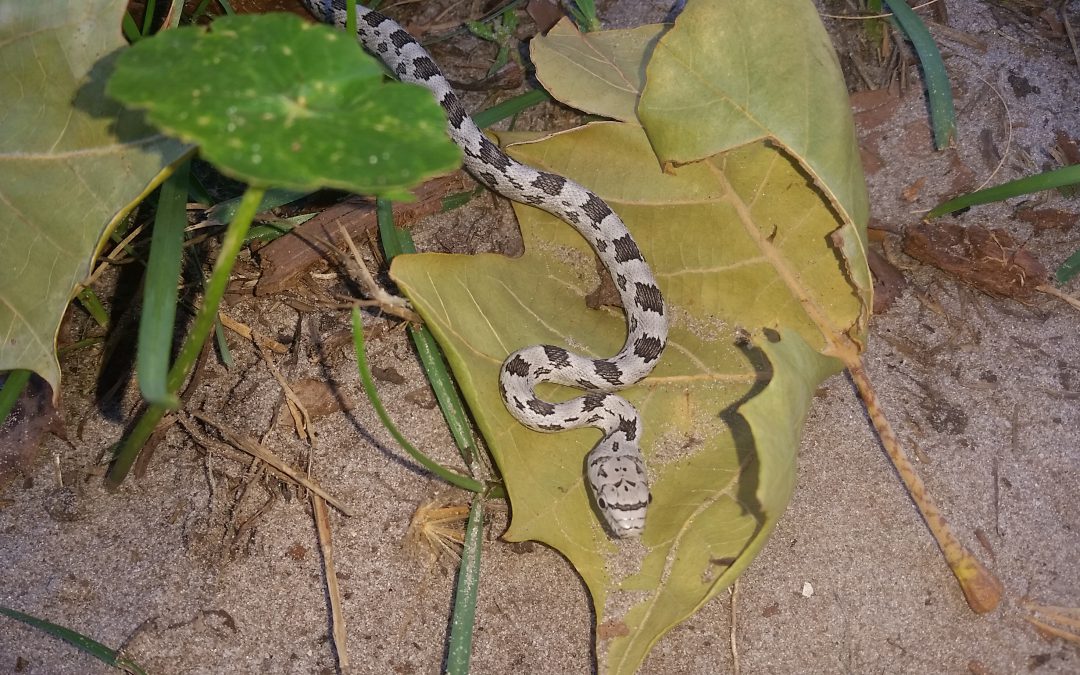
by Erik Lovestrand | Aug 27, 2021
It seems like there has always been a soft spot in my heart for snakes. From a young age, I was fascinated with all reptiles. The rural fabric of where I grew up in Central Florida (think late-1960s) afforded many opportunities for us kids to roam the woods and fields in search of adventure during summer vacation. I vividly remember the occasional eastern hognose snake that we would catch as kids. They were easy to house for a while, as there was no shortage of toads for a food source. This article will focus on some of the common species of snakes in NW Florida and a couple of snake safety tips.
Very likely, one of the first species of snakes most people encounter in North Florida is the gray rat snake (aka oak snake). If you raise chickens, you can greatly reduce the time it takes to enjoy your first encounter. I pull oak snakes out of our nest boxes on a regular basis. I have also encountered some rather large pine snakes in this manner; one with eight egg lumps in its mid-section. These are both harmless, beautiful creatures that can unfortunately make you hurt yourself in a dimly lit coop as you reach in to collect eggs. Another commonly encountered snake in our area is the corn snake, also called a red rat snake. The orange background and dark-red blotches make this one of our most beautiful species. Southern black racers are also a commonly seen species due to their daytime hunting habits. Racers are black on the back with a white chin and very slender for their length. They live up to their name and can disappear in a flash when startled. Two other species regularly encountered here are in the “garter snake” group. The eastern garter snake is one of very few species in our area with longitudinal stripes. They can have a tan to yellowish background color or even a greenish or blue color. The closely related ribbon snake looks similar in color and pattern but has a much slimmer build.

Gray rat snakes are also called oak snakes and are quite common in North Florida
My home county of Wakulla is home to four species of venomous snakes, which include the eastern diamondback rattlesnake, pygmy rattlesnake, coral snake and Florida cottonmouth. However, if you live in other parts of North Florida, you may have five or possibly even six species that are venomous. The copperhead’s range extends into North Florida in a few Counties along the Apalachicola River and the canebrake (or timber) rattlesnake ranges slightly farther south in the peninsula to North-Central Florida. I’ve only seen one canebrake rattlesnake and it was crossing a road on the north side of Gainesville many years ago. Both pygmy rattlers and cottonmouths can be very abundant locally in the right habitats but diamondbacks and coral snakes are less common these days having lost much of their preferred habitats to development.
My best advice for those worried about being bitten by a snake is don’t try to pick one up, and watch where you put your hands and feet. It really is relatively easy to avoid (key word here is avoid) being bitten by a snake. There are many good medical sites on the web with detailed recommendations for snakebite treatment. In the very rare circumstance when someone is envenomated, the best policy is to remain as calm as possible and head for medical attention. Do not cut the skin and try to suck out the venom or apply a tourniquet. These strategies generally cause more harm than good.
I always appreciate the chance to get a look at one of our incredible native snakes when afield, especially if it happens to be one of our venomous species. A big diamondback rattlesnake is an impressive animal to happen on when afield. This appreciation does not mean that I don’t get startled occasionally when surprised, but once that instinctive reaction passes, I can truly appreciate the beauty of these scaly critters.










